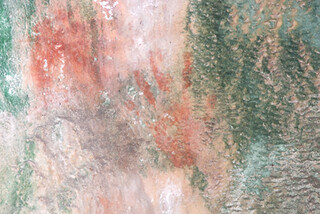View more photos for the Ancient CHamoru Cave Art entry here.
Ancient CHamoru/Chamorro Cave Art
Glimpse into the past
Table of Contents
Share This
Dating as far back as the Upper Paleolithic (around 10,000 to 40,000 years ago), humans have been producing art that has both captivated and puzzled archeologists. From figurines to body ornaments to carvings on spear shafts, archeologists have studied and marveled at the subject matter, variety of forms and degree of skill of ancient art. But what is “art?” What qualifies an object as art? Are spear points, fishhooks or pottery art? Generally, these are not considered works of art. But just because an object is functional, it does not mean it cannot be aesthetically pleasing, beautiful or artistic.
What distinguishes art from other objects or activities is the way we respond when we look at, create or perform art. Art has an evocative quality—it evokes feelings, emotions and ideas. From the point of view of the creator or the observer, art is meant to stimulate the senses, to give us a sense of pleasure, awe, even fear, depending on the piece or the performance. Like other aspects of culture, art is influenced by the shared ideas and practices of a society.
People create and respond to art based on meanings and ideas they learned in their culture. We develop pieces in a particular context or with the intention that our audience should be able to relate to our creation. We see that different societies have different characteristics or styles of art—for example, Hawaiian hula dance performances, Native American carved totem poles, Greco-Roman architecture, and intricately woven Marshallese fans and baskets. Each of these objects and performances are representative of and recognized as part of a unique culture or society.
In many ways, the art of ancient societies is just as compelling as modern art forms. Although specific meanings and contexts may not be known, archeologists attempt to understand how ancient peoples may have used art to communicate feelings and ideas and the cultural patterns from which these meanings emerge and make sense. One of the earliest and most intriguing forms of human artistic expression is cave art.
All over the world, different cultures have decorated rocks, rock shelters and caves with images of animals, people or other features of their surrounding environment. Archeologists distinguish between two basic kinds of rock or cave art—petroglyphs and pictographs. Petroglyphs are carvings made in the rock using stone tools or other implements to produce images or designs. Pictographs are painted images on the surface of exposed rock. Natural pigments, ash or lime may be used to produce the paints.
The most well-studied cave art is of Upper Paleolithic cultures in Europe and early Australian aboriginal rock art. In general, most cave art images have animal subjects, and very rarely are human figures depicted. In contrast, however, numerous CHamoru/Chamorro pictographs, seem to represent humans. Some archeologists propose that the depiction of humans or animals in cave art could be part of ritual magic. Whatever the motivation, the images left behind are a poignant reminder of the complexity of human culture and artistic endeavor.
Cave drawings first noted by Thompson
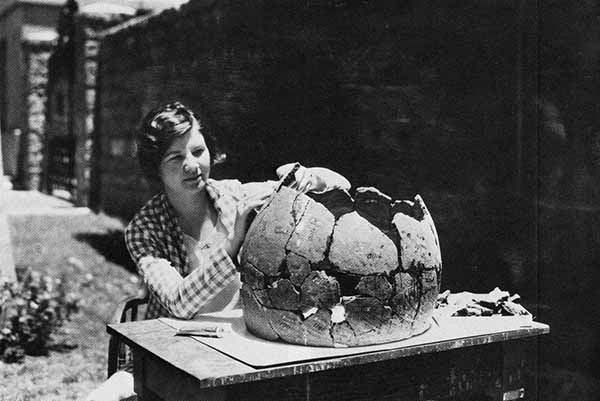
In the Marianas, archeologists have studied caves in limestone cliffs along the shores of the four southernmost islands. These caves or rock shelters are located at high elevations and at sea level at high tide marks. American anthropologist Laura Thompson described drawings that had been found in two caves, elevated some 400 feet above sea level, in Talofofo on the southwest coast of Guam. Another cave in Inalåhan on the southeast coast also contained wall drawings. In northern Guam, drawings were found on cave walls at Jinapsen and Mergagan Point (just outside the northern border of Tarague, currently within Andersen Air Force Base). Thompson also mentioned that drawings made from white pigment were found in caves in Laulau on Saipan. In these and other caves in the Marianas, archeologists have recovered human remains, potsherds (fragments) and different kinds of stone and shell implements.
Because of the difficulty of dating cave art, CHamoru pictographs have never been assigned a specific age. It is likely, though, that some of the images were created during the Latte Era or even during the beginning of the Spanish Era because of the presence of presumably European symbols, such as the Christian cross.
Pictographs were made by applying white paint or paste of limestone to the surface of cave walls or rocks, although red and black pigments also had been used. Design motifs varied, but consisted of animals and human figures, while other images appeared to be more symbolic. Human figures were mostly depicted as stick figures, some without heads.
In addition to Thompson’s report, other descriptions include caves with pictographs at Ritidian Point, Jinapsan and Tarague along the northern coast of Guam, Fena (currently Naval Magazine, Naval Station), Inalåhan, Talofofo, and Fadian Cave (on the east coast). The pictographs include human figures, circles and fish, among other drawings that are difficult to analyze.
It has been suggested that Marianas cave art could be associated with ancestor worship practices of the ancient CHamorus. The CHamorus believed that ancestral spirits (manganiti) remained on earth after death and could interact with living humans through the intercession of makahna (traditional herbalists and healers) to bring good fortune and success. Kakahna (spiritual healers) also had the power to interact with the manganiti, but for more malevolent purposes. The skulls of individuals who had died were removed from burials and kept by the deceased’s loved ones. The skulls were used by the makahna and kakahna to communicate with the spirits. Because some of the figures depicted in cave drawings are headless human figures, perhaps, these images could have represented the manganiti and the drawings were part of a larger complex of ritual and magic that enhanced communication with the ancestral spirits.
Gadao's Cave, Guam
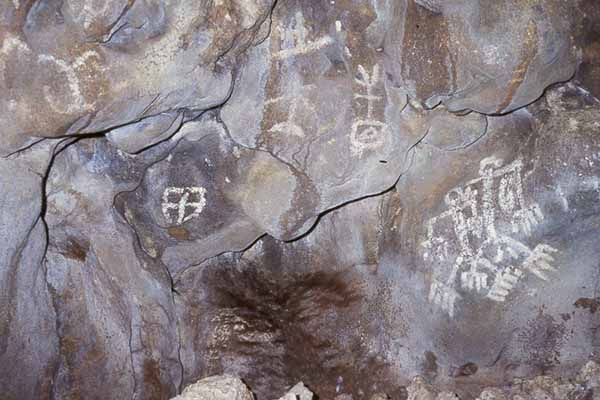
One of the best examples of CHamoru cave art can be found in Inalåhan at what is known as Gadao’s Cave. This limestone cave is located above the shoreline, approximately four meters inland. Previous archeological work had been done in the mid-1960s by Fred Reinman, and Gadao’s Cave was included on the United States National Register of Historic Places in 1974. Measuring three meters wide, two meters high and six meters deep, a group of about 50 pictographs are located on the west wall. The drawings range in size from two to three centimeters in height to twenty centimeters. The designs vary from geometric shapes to representational figures depicting human-like or animal-like forms. The pictographs likely were made using white lime that bonded to the wall with a chemical reaction. The lines of each drawing appear uniform in thickness, which implies they were made with the same kind of implement, or perhaps a finger.
The most well known drawings in Gadao’s cave are located on the east wall, and depict two human figures side by side, one of which appears to be holding something under his arm. It has been suggested that these figures are representative of the legendary Chief Gadao who challenged and outsmarted the northern chief Malaguana in a test of strength. This particular pictograph has been used extensively in commercial logos and art because of its significance as a symbol of CHamoru culture and identity. In recent years, Gadao’s cave has been subjected to vandalism, where this particular drawing was scratched superficially by a diagonal line.
Talagi Cave, Guam
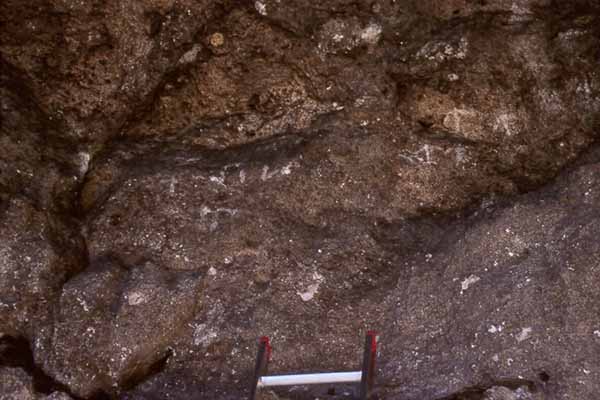
The Talagi pictograph cave is located on a piece of Government of Guam property on the northern edge of Tarague Beach on Andersen Air Force Base.
“Tarague” is the spelling used consistently on United States Geological Survey maps, while “Talagi” is another spelling introduced by the Guam Historic Preservation Office in 2006. The cave was first studied by American archeologist Hans Hornbostel in the 1920s, although his work was not reported until Laura Thompson’s 1932 publication on the archeology of the Mariana Islands. The abundant artifacts, including latte structures, grinding mortars, pottery, shell and stone tools indicate the area was inhabited by a single nucleated (as opposed to a dispersed) population. Early Spanish accounts from the late 1600s mention that Tarague had a large native population and although a church had been built there, Tarague was known as a center of rebellious activities during the CHamoru-Spanish War in the late 17th century. Hornbostel concluded that Tarague cave was an extensive pictograph cave because of the numerous white spots on the walls. However, his description of the pictographs did not correspond with pictographs later found high up on the wall at the entrance of the cave.
The cave is located at the base of a limestone cliff approximately thirty meters (about ninety-eight feet) high and twenty-five meters (about eighty-two feet) inland from the low tide mark. The cave opening measures about six meters (19.6 feet) from the ground to ceiling, fifteen meters (49 feet) wide and twenty-four meters (78 feet) deep. Damage caused by natural forces, as well as vandalism, and the running of waterlines across the cliff face are present. Of the nineteen archeological features observed in the cave, thirteen are pictograph figures. These include human figures, “V” and “T” shapes, and a straight line; the figures range in size from eight to eighteen centimeters (about three to seventeen inches) in height. The human figures are not uniform and some are missing limbs, heads or necks. Also visible at the cave are several mortars formed in the limestone, ranging from three and a half centimeters to eleven centimeters (one and a half to four inches) in depth, and between ten and sixteen centimeters (about four to six inches) in diameter. It is suggested that perhaps one or several individuals with similarly sized fingertips (or the same implement) may have painted the figures. Likewise, some kind of ladder must have been used to reach the area where the figures were drawn.
Ritidian Caves, Guam
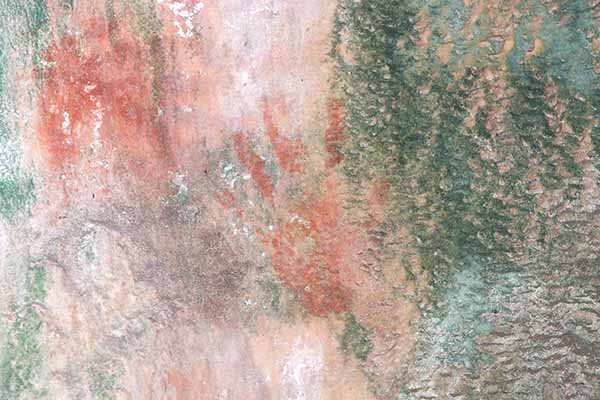
Located at the northwestern coast of Guam is an area known as Ritidian (Litkayan in CHamoru, which means “a stirring place,” presumably because of the rough ocean current there). Ritidian is the site of a fish and wildlife refuge but is also a place with much historical and cultural significance. The area was settled by the first inhabitants long before the arrival of Spanish explorers, and ancient fishing camps dating over 3,000 years ago have been uncovered in recent archeological investigations. Along the edge of the steep limestone cliffs between twenty-five and fifty feet high are a number of caves that contain ancient CHamoru cave drawings and handprints.
The drawings are of different figures, painted in limestone, charcoal and red clay. It is believed that in at least one of the caves, the images depict different constellations in the night sky, as well as an ancient star calendar. Sixteen dots arranged both horizontally and vertically divide the year into sixteen months of unequal length, based on the movements of the constellations. This calendar is different from the CHamoru lunar calendar which divided the year into 13 months and described the appropriate timing for fishing and farming activities. Also depicted are the constellations Orion, Cassiopeia and the Southern Cross. Although it is not known how the ancient CHamoru would have developed their knowledge of astronomy, an extensive knowledge of stars was essential for seafaring and navigation over long ocean voyages. This practice of star navigation has been maintained by Micronesian seafarers from the Federated States of Micronesia.
Also pictured are human figures, some missing heads, necks or limbs. Like the Talagi cave, there are associated stone mortars.
Liyang Kalabera, Saipan
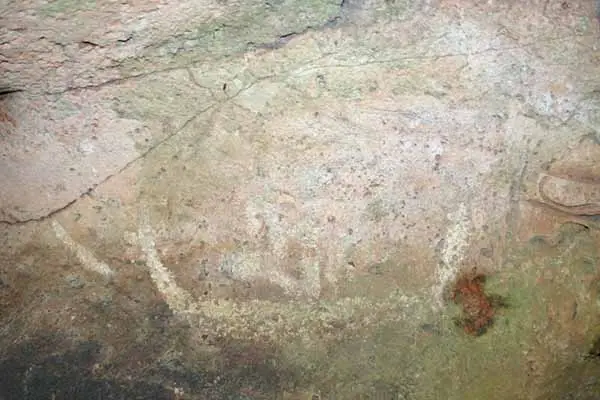
Known as Kalabera cave, this site is located on the northeastern ridgeline on the island of Saipan. Amidst the dense vegetation, the cave was utilized by Japanese civilians and military personnel during World War II, but was also used by ancient CHamorus prior to the arrival of the Spanish in 1521. The cave’s entrance has rock art within the first thirty to forty-five feet. The name Kalabera is a Spanish word that means skulls, and the cave contained skulls through the Spanish Era to the 1920s. Although not substantiated, some archeologists believe because of the presence of skeletal remains and the depiction of human figures, that this particular cave possibly was used as a burial site for CHamoru dead.
The cave is located at an elevation of about 300 feet. The entrance is about thirty to forty-five feet long, fifty-four feet wide and forty-five feet high. The interior of the cave has a vertical drop of about 100 feet, leading to a chamber filled with numerous cultural artifacts. In the 1920s, Hans Hornbostel produced the earliest photograph of one of the cave drawings depicting a human figure in a canoe, as well as other photographs of skulls. In addition to the pictographs are petroglyphs. These cave art images measure between five and ten inches high, the majority of them depicting human figures, painted with white limestone. Some figures are headless or missing limbs, however, a number of images are believed to be anatomically male figures with penises.
Unai Dangkulu, Tinian
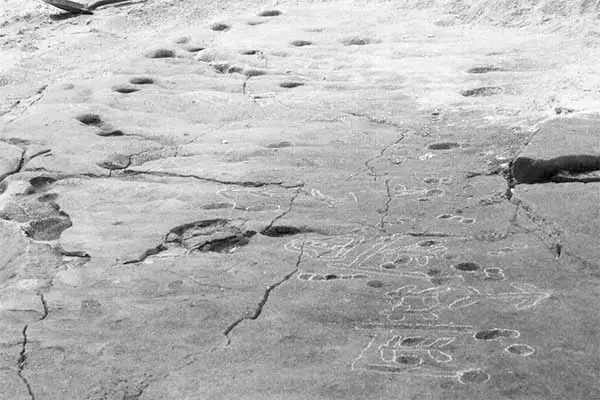
The site known as Unai Dangkulu stands out from other examples of CHamoru rock art because it exclusively contains petroglyph images etched on the outside of a cave. Unai Dangkulu literally means “big sand,” or “big beach,” and is located on the northeastern coast of Tinian. The petroglyphs are found on a flat coral limestone outcrop, approximately twenty to thirty feet from the high water mark, and about 260 square feet in area. It is not clear how the CHamorus produced these images, although it must have been difficult or time-consuming, given the kinds of CHamoru tools available.
There are approximately fifty distinct images, many of which are human-like, without heads. There are also a number of circular cup-like depressions, smaller rectilinear forms, and at least two figures that resemble sea turtles. The images were discovered in 1998 after a typhoon washed away sand that had covered the petroglyphs. A nearby ancient village with latte sets as well as a quarry site may be associated with Unai Dangkulu.
Liyang Chugai, Luta (Rota)

Chugai Cave sits on the rim of a plateau along the southeastern coast of Rota, about 450 feet above sea level. Beginning along the east wall of the cave and proceeding to the back of the chamber, are images painted with black pigment. It has been suggested that this black pigment may be charcoal or ash, or a plant pigment combined with some kind of binder, similar to the pigment traditionally used to color or stain teeth. The lack of natural lighting may have compelled the artists to bring in another source of light to help them visualize their work. The pictographs depict human figures, but more remarkable are two images of realistically painted sea turtles, just under a foot in size, and another depicting a bill fish, over three feet in length.
Preservation is key
No one has been able to decipher the meanings of the different pictographs found in the Mariana Islands, but it is suggested that the pictographs may have functioned in cultural ceremonies of the ancient CHamorus to ensure successful fishing or hunting expeditions. Depictions of headless, limbless or bent limb figures could be reflections of ancient burial practices and treatment of the dead. The association of limestone mortars could indicate that makahna and kakahna were using the mortars as part of ritual or religious ceremonies performed at the caves. With the establishment of Spanish colonial administration and the Roman Catholic mission, other symbols and meanings may have been incorporated or represented on cave walls as well.
Because of the rarity and cultural/historical significance of CHamoru cave art, it is important that these sites be well preserved. Unfortunately, damage from natural forces over time, such as flooding and typhoons, is difficult to control, and is expected to have some effect on the drawings. Even more disheartening is that some of the cave sites have been impacted by acts of vandalism, while construction projects, development and human intrusion likewise pose threats to these areas. Perhaps future studies of CHamoru cave art will provide clues on the cosmology and system of symbols of ancient CHamoru society, and encourage greater care and public policies to preserve these culturally significant sites.
For further reading
April, Vic. “Talagi Pictograph Cave, Guam.” Micronesian Journal of the Humanities and Social Sciences 5, no. ½ (November 2006): 53-69.
Cunningham, Lawrence J. Ancient Chamorro Society. Honolulu: Bess Press, 1992.
Ember, Carol R., Melvin Ember, and Peter Peregrine. Anthropology. 12th Edition. Upper Saddle River: Prentice Hall, 2007.
Russell, Scott. Tiempon I Manmofo’na: Ancient Chamorro Culture and History of the Northern Mariana Islands. Saipan: Commonwealth of the Northern Mariana Islands Division of Historic Preservation, 1998.
Thompson, Laura M. Archaeology of the Mariana Islands. Bernice P. Bishop Museum Bulletin, No. 100. Honolulu: Bishop Museum Press, 1932.
US Department of the Interior National Park Service. General Report on Archeology and History of Guam. By Erik K. Reed. Sante Fe: NPS, 1952.






